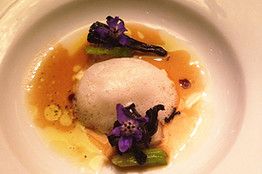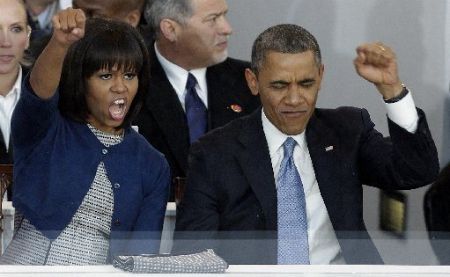
Smoked oyster in a glass dome
filled with apple wood smoke
From Chef Jose Andres' Washington D.C.
Restaurant Minibar
There a post at Diana West's site, where she reproduced a full article from Barron's Penta Daily, which describes the restaurant where the Obamas dined for Valentine's Day.
She prefaces it with an image of a "dragon's breath" and writes:
Minibar's "dragon's breath" course is a curried popcon ball dunked in liquid nitrogen.What does this have to do with reclaiming beauty?
Did the president eat it in one bite, as staff suggests, so vapor would stream from his nose?
Well, it goes with the theme of reclaiming beauty. I will post this under the topic "Gastronomy." Food can be an art. Chef's are culled from prestigious restaurants to create meals that are visually and aesthetically superior for those who can afford it who hopefully are also those who can appreciate them.
I cannot imagine Michelle Obama as an epicurean. What would she do with "a smoked oyster...in a glass dome filled with apple wood smoke?" Obama, perhaps, would be more appreciative. But his leftist, black "inner voice" would prevent him from taking it all in neutrally, and it would probably be grading, comparing, and finally rejecting this as "one of those white people things" even as he eats it. He would be destroying even as he, in elitist fashion, understands its superior culinary qualities.
And of course, Michelle will give him the much required backing - for the destruction part, and by bringing him "back to black reality."

Below is the article from West's site:
In case anyone is wondering what the Obamas' Valentine's Day dinner out at Minibar was like, here is a recent Barron's review of dinner for two, which came to $958.-----------------------------------------------------------------------------------------------------------------------------------------------------
From Barron's Penta Daily: Insights and advice for families with assets of $5 million or more [no wonder I never read it before]:"A Bargain Dinner at $500 a Head"
At 6 p.m. on a rainy night this week, my guest and I sat down at the counter of Washington D.C.’s Minibar. Only six privileged guests at a time dine here on a 26-course meal handcrafted by Chef Jose Andres and his young staff.
One of the most acclaimed restaurants in the country, there is no shingle announcing Minibar on the corner of E and 9th streets, just an anonymous frosted-glass door of the type I’ve previously seen at private banks on the Bahnhofstrasse in Zurich. But behind the door stands a hostess with iPad. She took us from the white foyer to an adjacent waiting room, where more smart-looking staff brought us a cocktail, hot towel, and a wooden box filled with seaweed-dusted rice crackers.
We privileged six were ushered behind a diaphanous curtain, to the island counter where two dozen staff members stood waiting to serve us. The minimalist white-walls and chairs, coupled with banks of steel cooking ranges, created an aesthetic I would describe as 1960s Courreges-meets-Japanese-sushi-bar.
I was, quite frankly, unprepared for what followed. A dozen talented chefs ranging in age from 21 to 34, performed for us a culinary ballet, starting with a frozen cocktail made with St. Germain, a liqueur of distilled Alpine elderflower, and served in the form of a snowball. A wine-red pillow the size of a postage stamp was decorated with a dainty white flower; it was filled with peanut butter and jelly.
A pink piggy made of meringue tasted of apple until you bit into the center “sorbet” made of bacon. My favorite of these amusing dishes looked like a macaroon, but exploded bomb-like with buttery goose liver. The chef showed us how a metal ring reaching 248 degrees Fahrenheit created a thin sugar-shell holding together the light and airy foie-gras mousse.
Minibar’s “baby carrots with coconut” is built on a technique famously invented by Chef Ferran Adria of Spain’s now-closed elBulli. Deconstructed carrots are rebuilt so an invisible outer skin, shaped as a carrot, encases an intense liquid essence of the vegetable. Minibar surrounds its “carrots” with dribbles of olive oil, exotic spices, and coconut flakes, creating a rolling wave of salty, soothing, sweet and piquant flavors in the mouth. A chef told us the dish took them 2.5 years to perfect.
While diners can order an expensive bottle of wine to go with their meal, I highly recommend sticking to the beverage packages designed to accompany the weird dishes. My buddy had the $75 “Experience,” twelve glasses that started with an amontillado sherry. I had the $200 “Jose,” which began with a Krug Grande Cuvee Brut Champagne and included, with some big names, a stunning Movia Sauvignon Blanc Primorje from Slovenia.
A smoked oyster arrived in a glass dome filled with apple wood smoke, and sat in an escabeche-style sauce of roast chicken stock and sherry vinegar. Their delicate white beans-and-clams dish from Asturias was tarted-up with slivers of pickled garlic, and was an homage, the lead chef told us, “to our boss.” Meanwhile, the simple “eggs and toast” was made sublime by an “egg white” actually made of Parmesan cheese.
Not every dish was a home run. In one, a morsel of lobster was ringed by yogurt, walling in a pool of chicken wing-and-lobster stock. The sauce didn’t fuse the competing yogurt-and-sea flavors for me. The chef said they had gone through 100 permutations and were still working on the dish.
For sheer fun, nothing beat the “dragon’s breath,” a cube of curried popcorn dipped in liquid nitrogen at the table. A furious stream of smoke roared out of my nostrils, like a dragon, when I bit into it. “Pine snow with honey” was an elegant dish of decorative pine branch and pine nuts, sprinkled with what looked exactly like icy snow, but was in fact a specially treated cheesy-yogurt, dribbled with honey. Two hours later, in yet another bar-type room, we had coffee, cognac, and a host of unique petits fours.
The waitress brought an egg to our table, smashed it with her fist, revealing our bill. The dinner cost $958 for two.
It’s a bargain. There is no way, even at those prices, that Chef Andres is making money on Minibar, considering the labor needed to create and “perform” each dish; only 24 guests, eating in staggered shifts, are picked each night from the 100 to 300 reservation requests that are emailed a month in advance. Minibar is really a “laboratory of ideas,” the creative lifeblood of Jose Andres’ successful group of restaurants and the ideal training ground for young chefs learning their boss’ style and ethos. This is not comfort food, but it is great theater, an evening filled with artistry of the highest order.
By: Kidist P. Asrat
